Root former for cuttings: an overview of the best
Many shrubs, herbaceous perennials and some trees multiply cuttings... In order for the roots to form on them sooner, special root-forming stimulants are used.
Content:
- Root formers - what is it?
- Most popular drugs
- Do-it-yourself root formers
- Features of the use of drugs
Root formers - what is it?
Root formers are drugs that promote the rapid formation of powerful root system... Most of them contain phytohormones that speed up the metabolism near the cut site. As a result of their activity, a large amount of nutrients are sent there.
The phytohormones of the root former help the phytohormones found in each plant to form callus and roots faster. This is especially evident on cuttings of conifers and fruit trees.
It is advisable to use root formers for cuttings in such cases:
- For better rooting of perennial crops (herbaceous and trees).
- To eliminate the impact of stressful situations.
- To save dying plants. This method is used in exceptional cases.
It is impossible to use root formers systematically. After all, this is a very powerful remedy.
Most popular drugs
Among industrial root formers for cuttings, the most popular are:
- "Heteroauxin" is a white powder containing phytohormones of the auxin group (beta-indoleacetic acid). It is sold as a potassium salt in powder or tablet form. To reduce the chances of counterfeiting, it is best to buy tablets. They, like powder, are quite difficult to dissolve completely. To do this, place a tablet in a gauze bag, a dropper filter and dipped in soft water. Dissolve the tablet in 0.5 l of water. This amount is enough to process 50 cuttings. Plants should not be pollinated with this drug. You can dip the cuttings in powder for a couple of seconds or soak them in a solution. The drug works better in the dark. Therefore, cuttings of herbaceous plants are soaked overnight until 16:00, lignified ones - up to 20:00. The dosage for each of the plants should be seen in the instructions. But the amount of the drug, the shelf life of which has exceeded 2.5 years, is doubled. The prepared solution can be stored for 2 days.
- "Heteroauxin" belongs to the 3rd hazard class. A tablet of "Heteroauxin" or "Kornerosta" is dissolved in 5 liters of soft water. Cut the cuttings, if possible, just before processing. Greens are soaked for 10 ... 16 hours, lignified - from 16 hours to a day. Immediately after processing, the cuttings are planted in the ground. The root former not only stimulates the rooting of cuttings. After treatment with the drug, flowers and seedlings take root better.
- "Kornevin" has another active ingredient, indolylbutyric acid. It is a beige powder. The ends of the cuttings are dipped in it immediately before planting. Do not take more of the drug, you need to shake it off the handle. An excess of "Kornevin" can lead to the death of the plant. To protect the cuttings from too strong a biostimulant effect, you can mix it in equal proportions with crushed activated carbon.Indolebutyric acid irritates surface tissues and promotes callus formation. Once in the soil, it is converted to heteroauxin. If you add ascorbic acid or vitamin B1 to the preparation, the shoots formed then will also grow faster. To soak the bulbs, use the Kornevin solution. The tips of the cuttings can also be immersed there. But more often powder is used for this. "Kornevin" refers to drugs of the 3rd hazard class. You need to work with it with gloves, do not use food utensils. When the drug enters the body, they take activated charcoal and drink a lot of water. You can drink a mild manganese solution and induce vomiting. Store "Kornevin" in a glass jar with a tight-fitting lid. When buying a product, they carefully look at the date of manufacture and expiration date. After all, it is usually used infrequently, so there must be a spare time for storage.
- "Epin" is used for fast rooting of cuttings, protection from frost, drought, disease and other stresses. Dissolve 0.5 ml of the drug in a liter of water. Cuttings are soaked in solution before planting.
- "Zircon" refers to multifunctional complex preparations. It accelerates the process of root formation, enhances flowering, helps to cope with fungal and viral diseases, and to adapt to natural conditions. A remedy is prepared from Echinacea purpurea. Dissolve 1 ampoule in a liter of water. Used for soaking for 14 hours. The drug is compatible with Heteroauxin.
- «Ribav extra»Created on the basis of ginseng. The effectiveness of the drug reaches 100%. 1 ml of the drug is enough to prepare 10 liters of an aqueous solution. Promotes rapid acclimatization of transplanted plants and wound healing.
Do-it-yourself root formers
An industrial root former is not always at hand. But it can be successfully replaced using substances that are in the house:
- The juice aloe stimulates the plant's immune system and promotes the rapid formation and growth of roots. Use 30 ml of juice per liter of water.
- Honey is an excellent immune stimulant. A teaspoon of honey is dissolved in 1.5 liters of water. The shank, immersed in a third of the length, is kept for 12 hours.
- Yeast (100 g) is dissolved in 1 liter of water, the cuttings are immersed for a day. Before planting, rinse and place in a jar of clean water for germination.
- Willow, willow, poplar germinating in a jar of water, creates conditions for the rapid formation of roots. After the sprouted willow branches are taken out of the water, cuttings of other plants are placed in it. Keep them until roots are formed.
- Rooting cuttings roses in the potato tuber is becoming more and more popular. This is a very convenient method that can be used for rooting cuttings of other plants. You just need to cut out all the eyes of the potato so that it does not germinate, dig in the ground, cover with a jar and water it periodically.
Features of the use of drugs
Despite the fact that each of the drugs has its own characteristics of use, there are general rules:
- The root former is prepared immediately before use.
- Cuttings are processed immediately after cutting. It is better to take them from a young tree, preferring the lower ones located at the beginning of the branch.
- The temperature in the room or outside where the procedure is carried out should be in the range of 20-23 ° C.
- To soak the cuttings, use glass, enamel or porcelain dishes. Do not use metal.
- The amount of water in the dishes should be small so that all of it is saturated with oxygen. Do not forget that the roots are formed on the verge between water and air. Therefore, a lot of water should not be poured.
- The water is not changed during germination. If there is very little of it left, add fresh. If you pour out the old water and pour in new water, the formation of roots may stop and the plant may die.
- Green cuttings are immersed in a third, lignified - in half or two-thirds.
More information can be found in the video:



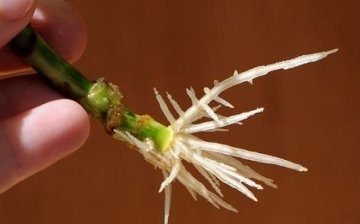
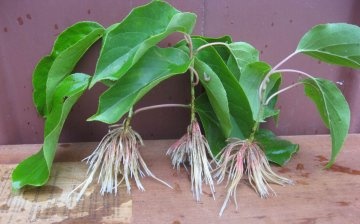
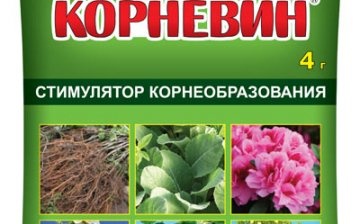
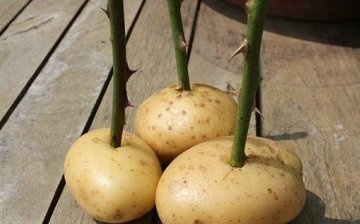
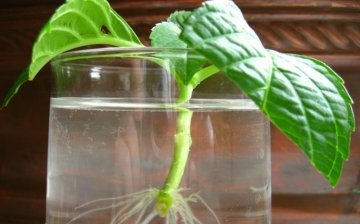






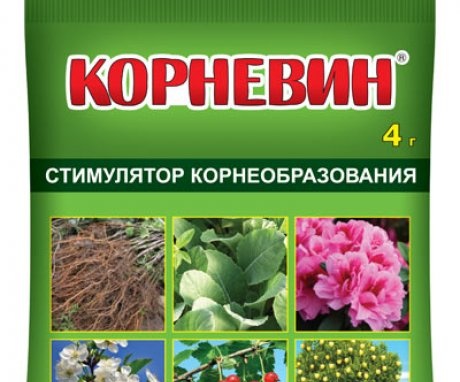
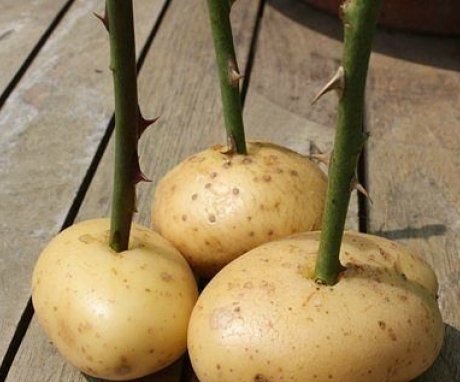
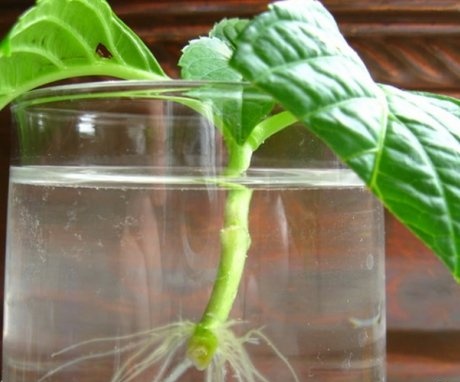
I believe that a viable stalk should give roots on its own, without the intense influence of various stimulants, if necessary, you can provide an additional supply of organic matter, but most often this is superfluous.